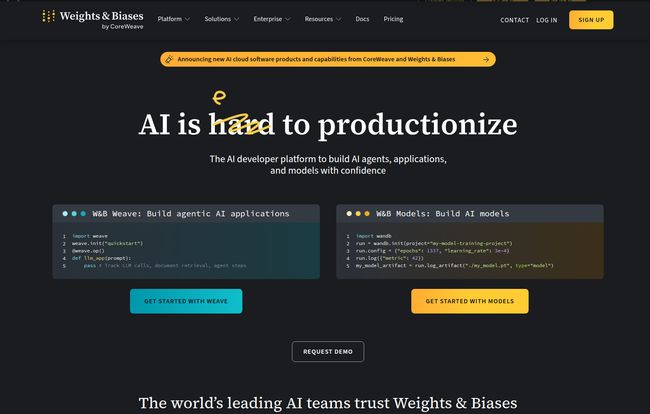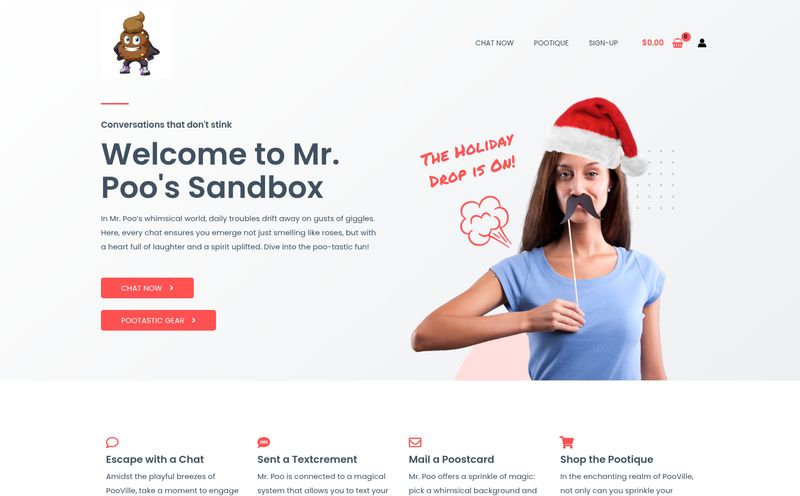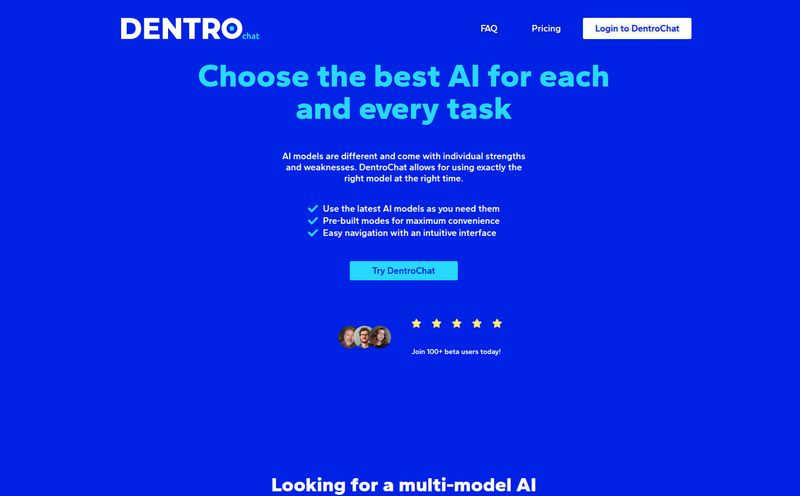If you've spent any serious time building AI models, you know the feeling. You're in the zone, tweaking code, running experiments, and suddenly you create a version of your model that's... perfect. It's a miracle. But then, a week later, you can't for the life of you remember which dataset you used, what the learning rate was, or why that one weird hyperparameter made all the difference. It's chaos. Pure, unadulterated, "where-did-I-save-that-model-v7_final_final2" chaos.
I've been there more times than I care to admit. Over the years, I've seen countless tools that promise to be the silver bullet for machine learning development. Some are clunky, some are too simple, and some are just... well, they're just another dashboard. So when I started hearing the buzz around Weights & Biases, I was skeptical. Another one? But the more I saw it pop up in serious dev circles, used by teams at places like OpenAI and Microsoft, the more I thought, okay, maybe there's something here.
This isn't going to be a sterile list of features. This is my brain dump, my honest take, on a tool that's genuinely changed how I approach AI projects.
So, What Exactly is Weights & Biases?
If you had to pin me down, I’d say Weights & Biases (or W&B, as the cool kids call it) is mission control for your AI projects. It's an AI developer platform designed to track, visualize, and manage your work from the very first experiment all the way to production. Think of it like a lab notebook on steroids, mixed with GitHub for models, and a killer BI dashboard, all rolled into one.
It’s the digital equivalent of a lab scientist meticulously labeling every single beaker, logging every temperature change, and noting every unexpected fizz, ensuring that a breakthrough can be replicated and not just a happy accident. W&B takes that discipline and applies it to the wonderfully messy world of machine learning.
The platform is neatly broken down into a few core areas:
- Core: The foundational tools for tracking experiments, visualizing results, and reporting on your findings.
- Registry: A centralized place to store and version your models and datasets. No more hunting through folders!
- Weave: A newer tool designed to help you build and monitor those complex, agent-based AI applications everyone's talking about.
- Models: The whole lifecycle management, from training runs (Sweeps) to deployment.
It's a comprehensive suite. And honestly, it feels like it was built by people who have actually felt the pain of developing AI.

Visit Weights & Biases
The Core Features That Actually Matter
A long feature list can be overwhelming. Let’s cut through the noise and talk about the parts of W&B that have become indispensable to my workflow.
Experiment Tracking: Your Sanity Saver
This is the bread and butter. The absolute cornerstone. With a simple `pip install wandb` and a couple of lines of code in your Python script (`import wandb` and `wandb.init()`), you're suddenly logging everything. Hyperparameters, metrics like accuracy and loss, system stats (hello, GPU memory usage!), and even complex media like images or charts. It all gets beamed up to your personal W&B dashboard in real-time. The feeling of running a dozen experiments overnight and waking up to a clean, beautiful set of graphs comparing all of them? Chef's kiss. It turns the chaotic art of model tuning into a repeatable science.
Beyond Experiments: The Full MLOps Lifecycle
Tracking is great, but what happens when you have a model you want to keep? That's where the Model Registry and Artifacts come in. An "artifact" can be anything—a dataset, a model weight file, a configuration file. W&B versions them, creating a clear lineage. You can see exactly which dataset and which code produced which model. This isn't just nice to have; for any serious project, this kind of reproducibility is non-negotiable.
And I have to mention Sweeps. This is W&B's tool for hyperparameter optimization. You define a range of parameters to try, and Sweeps automatically runs the experiments for you, searching for the best combination. It's like having a tireless intern who loves number-crunching.
Riding the GenAI Wave with W&B Prompts and Weave
The whole industry is pivoting towards Large Language Models, and W&B is right there with them. This isn't just a classic ML tool with a new coat of paint. W&B Prompts is a suite of LLMOps tools specifically for the dark art of prompt engineering. It lets you track, compare, and manage your prompts and their outputs, which is a massive headache to do manually. And W&B Weave is their answer to building, debugging, and monitoring the new wave of AI agents. This shows they’re not just keeping up with trends; they're building the infrastructure for them.
Who is This Platform Really For?
I see W&B fitting into a few key camps:
For the solo developer, student, or academic researcher, the free tier is an absolute gift. The fact that it's "Free forever for academic research" is a massive statement of support for the open-source and research communities. You get all the core functionality for your public projects. What a fantastic way to learn best practices from day one.
For a startup or small team, the Pro plan makes a ton of sense. This is where you get private projects, more storage, and collaborative features. It introduces a level of professionalism and organization that can be the difference between a stalled prototype and a shipped product.
For the large enterprise, the full-blown Enterprise plan provides the security, support, and scale they need. Things like SSO, dedicated support, and flexible deployment options (SaaS, dedicated cloud, or even on-prem) are critical when you're operating with serious data and compliance requirements.
Let's Talk Money: The W&B Pricing Breakdown
Okay, the big question. What does it cost? The pricing model is refreshingly straightforward.
| Plan | Price | Best For | Key Features |
|---|---|---|---|
| Free | $0 | Individuals & Academics | Unlimited public projects, core experiment tracking, community support. |
| Pro | Starts at $50/user/month | Small Teams & Startups | Everything in Free, plus private projects, increased storage, and email support. |
| Enterprise | Custom | Large Organizations | Everything in Pro, plus SSO, advanced security, dedicated support, and custom deployments. |
My take? The pricing is fair. When you calculate the hourly cost of a single data scientist's time, spending a few hours trying to reconstruct a past experiment easily costs more than a month of the Pro plan. It's an investment in efficiency and sanity. And again, that free tier for public and academic work is just... awesome.
The Good, The Bad, and The Complicated
No tool is perfect, and it wouldn't be an honest review without touching on the downsides. In my experience, W&B is incredibly powerful, but that power comes with a bit of a learning curve. If you're coming from a world of just `print()` statements and spreadsheets, it can feel like a lot at first. You do need some comfort with Python and the command line to get the most out of it. It’s not a no-code solution by any stretch.
But the good stuff? Oh man, the good stuff is good. The platform is truly comprehensive, covering the whole lifecycle. Its integrations with everything from PyTorch and Keras to LangChain and OpenAI are seamless. It just works. Most importantly, it feels like it's built with a strong opinion on how MLOps should be done, and I happen to agree with that opinion.
Some might argue that open-source alternatives like MLflow give you more control, and that's a fair point. I've used MLflow, and it's a solid tool. But I often find myself spending more time managing the MLflow server itself than doing actual ML work. With W&B, especially the SaaS version, I can just focus on building models. For me, that's a trade-off I'm happy to make.
Is Weights & Biases the Right Tool For You?
So, here we are. After all that, should you use it?
If you're a student or a hobbyist dipping your toes into AI, the free plan is a no-brainer. Start with it. Learn the right habits from the beginning.
If you're a professional or part of a team that's feeling the pain of disorganized, irreproducible experiments, you should seriously evaluate the Pro plan. Run a trial. I have a strong feeling you won't want to go back.
In a field that moves at lightning speed, where today's state-of-the-art model is tomorrows baseline, having a solid home base for your experiments isn't just a luxury—it's essential for survival. For me, and for many of the sharpest teams I know, Weights & Biases has become that home base. It brings a welcome sense of calm to the beautiful, brilliant chaos of building AI.
Frequently Asked Questions
- What is Weights & Biases used for?
- Weights & Biases is an MLOps and LLMOps platform used by AI developers to track experiments, version models and datasets, manage prompt engineering, and oversee the entire machine learning lifecycle from development to production.
- Is Weights & Biases free?
- Yes, W&B has a generous free tier for personal and public projects. It's also free forever for academic users and research, which is a huge benefit for the community.
- Do I need to know how to code to use W&B?
- Yes, for the most part. W&B is a developer-first tool. While the dashboards are visual, integrating it into your workflow requires writing code, primarily in Python, to log your experiments and artifacts.
- What is W&B Weave?
- W&B Weave is a specific toolkit within the Weights & Biases platform designed for building, debugging, and evaluating modern AI applications, particularly those that are "agentic" or use complex chains of LLM calls.
- How does W&B compare to an open-source tool like MLflow?
- Both are excellent for experiment tracking. MLflow is open-source and highly customizable, but requires you to manage your own server. W&B is a managed service (though on-prem is available) with a more polished UI and integrated features like LLMOps and collaborative reports, offering a more seamless out-of-the-box experience.
- Can I use Weights & Biases for my personal projects?
- Absolutely! The free tier is perfect for personal projects. The only main condition is that your projects will be public, which is great for building a portfolio and sharing your work.



